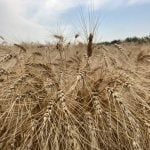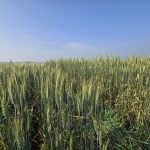Upside Robotics is rapidly advancing its Maize Runner nutrient application robot, with about 20 robots running autonomously on Ontario farms this growing season, compared to one that was operated remotely last year.
Why it matters
Nitrogen is one of the largest costs for crop farmers, so reducing nitrogen application levels would save input costs, and reduce environmental impact.
The Upside Robotics robot would be a paradigm shift in how crop nutrients are managed, especially in corn, with small robots that run between 30-inch corn rows applying a precise amount of fertilizer as needed weekly. That compares with fertilizer being applied in large volumes on a planter, or large spreaders and sprayer units applying nutrients a couple of times per year.
The aim is to have all nutrients applied by the robot, in a liquid form, eliminating the need to apply fertilizer at planting. This reduces weight on the planters and eliminates the need to stop and refill with fertilizer during planting.
“The farmer’s not having to manage nitrogen supply or nitrogen application at all on the fields where we’re running. That takes a lot of pressure off them,” says Tanya Franklin, vice president of agronomy and strategic partnerships, with Upside Robotics.
Less fertilizer, same or more yield
Franklin says 2024 trials showed fertilizer application could be reduced from 30 to 70 per cent without impacting yield.
They produced 250 bu./ac. corn with 55 pounds of nitrogen applied.
The possibility of easier fertilizer management, while reducing fertilizer use has attracted interest from farmers, says Franklin. More than 100 Ontario farmers have expressed an interest in the technology, and there’s increasing interest in the Midwestern United States.
The Waterloo-based company hopes to have products available for sale by 2027.
Its CEO, Jana Tian, is attracting interest in Canada and the United States. She pitched her product at the AgTech Breakfast at Canada’s Outdoor Farm Show one day, and spoke at the Autonomous Nation 2025 event at the Grand Farm research farm in North Dakota the next day.
Tian founded Upside Robotics with a partner a few years ago and developed the first robot while based in San Francisco. They moved to Ontario because of its corn growing and robotics expertise, which Tian called “the best thing we’ve done.”
During an interview in the OMAFA Innovations Pavilion, Franklin explained the upgrades that the team has made over this growing season.
The Upside Robotics robots are deployed with a base station that combines tanks for liquid fertilizer and a charging station for the robots, powered by solar panels. Franklin says the base stations will be decreasing in size as they are redesigned to be more modular, but they only need a 30-square-foot area.
The robots have become more reliable through the season, she says, as they’ve fixed problems ranging from fertilizer tank leaks to designing an RTK system that works for a tiny 24-inch-wide robot.
To use the system, farmers have to soil test and map fields with gamma radiation. Upside Robotics has partnered with Soil Optix, a Canadian company doing such soil mapping.
The company then has a 3.5 metre by 3.5 metre grid across the field that includes information on soil variability, organic matter, nutrients and cation exchange capacity.
That allows the company’s software to calculate how much nitrogen the soil is mineralizing, so that the robot can apply the difference between the crop demand and what’s available.
They are also attaching multispectral cameras to the robots so that the robot can evaluate the health of the corn as it moves through the field, especially to identify nitrogen deficiencies.
The robots will be most efficient in fields that range from 50 to 100 acres, she says. Corn, as the largest nitrogen user, is the focus for now, but Franklin expects the company to try other crops in the future. Other fertilizers can be applied, including micronutrient dosing.
Franklin says spot applying fertilizer is the next evolution in crop fertilization.
“The application of fertilizer has seen many generations already. We went from just manure, to dry fertilizer, to liquid fertilizer, to then split applying. A lot of them (farmers) see this as the next evolution of fertilizer application, especially on corn,” she says.














